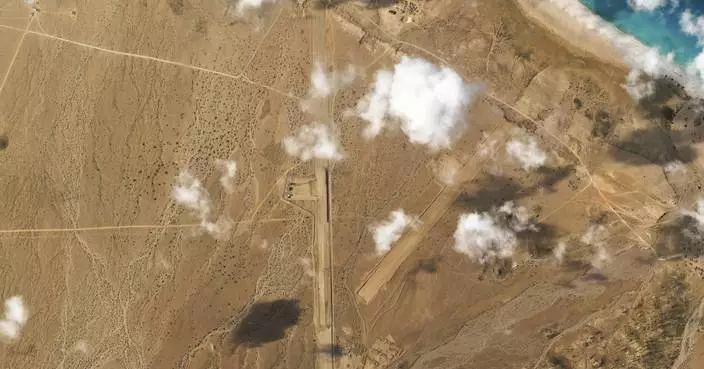The United Nations warned Wednesday that its programs to fight the coronavirus in war-torn Yemen might have to stop by the end the month unless they get an immediate injection of cash.
The warning comes a day after a U.N. appeal for countries to fund emergency aid in the Arab world’s poorest nation fell a billion dollars short of what aid agencies needed — $2.41 billion — to cover essential activities from June to December.
“This will severely handicap efforts to contain the outbreak, which is already spreading rapidly,” said Hayat Abu Saleh, a spokesperson for the U.N. Officer for the Coordination of Humanitarian Affairs.
At least 31 major U.N. programs in Yemen, covering essentially every sector, from food to health care and nutrition, were at a “serious risk of significant reduction or closure,” she said.
The coronavirus is threatening to decimate Yemen's health care system, already ravaged by more than five years of civil war. Abu Saleh predicted the U.N. would likely start winding down some of its disease outbreak and control programs next month, including efforts to contain cholera, malaria and dengue fever, among other diseases.
She urged the donors to honor their pledges “immediately.” Tuesday’s conference raised $1.35 billion — half of what is needed and half of the $2.6 billion that countries pledged at the same conference last year.
Saudi Arabia, which co-hosted this year's U.N. pledging event, said it would pay half a billion dollars in aid for Yemen, $300 million of which will be funneled to the U.N. and related aid agencies. It was the largest amount pledged by any country.
Separately, Jan Egeland, the secretary general of the Norwegian Refugee Council, also called for the money pledged on Tuesday to be “disbursed immediately" and urged warring parties to stop fighting and focus their efforts to fight the pandemic.
“Donors who failed to put their hands in their pockets must step up,” he said.
“But money alone is not enough,” Egeland added. “These pledges are worth little if people are still fleeing from bombs and crossfire and their hospitals attacked.”
Since April, authorities in areas controlled by Yemen’s internationally recognized government have reported around 400 coronavirus cases, including 87 deaths. The Iran-backed rebel Houthis, who control most of the country's north including the capital of Sanaa, have declared only four cases, including one death.
The World Health Organization believes that there is significant underestimation of the outbreak, which could further hinder efforts to get supplies into Yemen needed to contain the virus.
Yemen's civil war erupted in 2014, when the Houthi rebels captured Sanaa, forcing the internationally recognized government to flee. In the spring of 2015, a U.S.-backed, Saudi-led coalition began a destructive air campaign to dislodge the Houthis while imposing a land, sea and air embargo on Yemen.
The conflict has killed more than 100,000 people and driven 4 million Yemenis from their homes. Cholera epidemics and severe malnutrition among children have led to thousands of additional deaths.
That coffee you slurped this morning? It’s 600,000 years old.
Using genes from coffee plants around the world, researchers built a family tree for the world's most popular type of coffee, known to scientists as Coffea arabica and to coffee lovers simply as “arabica.”
The researchers, hoping to learn more about the plants to better protect them from pests and climate change, found that the species emerged around 600,000 years ago through natural crossbreeding of two other coffee species.
“In other words, prior to any intervention from man,” said Victor Albert, a biologist at the University at Buffalo who co-led the study.
These wild coffee plants originated in Ethiopia but are thought to have been first roasted and brewed primarily in Yemen starting in the 1400s. In the 1600s, Indian monk Baba Budan is fabled to have smuggled seven raw coffee beans back to his homeland from Yemen, laying the foundation for coffee’s global takeover.
Arabica coffee, prized for its smooth and relatively sweet flavor, now makes up 60% - 70% of the global coffee market and is brewed by brands such as Starbucks, Tim Horton's and Dunkin'. The rest is robusta, a stronger and more bitter coffee made from one of arabica's parents, Coffea canephora.
To piece together arabica coffee’s past, researchers studied genomes of C. canephora, another parent called Coffea eugenioides, and more than 30 different arabica plants, including a sample from the 1700s — courtesy of the Natural History Museum in London — that Swedish naturalist Carl Linnaeus used to name the plant.
The study was published Monday in the journal Nature Genetics. Researchers from Nestlé, which owns several coffee brands, contributed to the study.
The arabica plant’s population fluctuated over thousands of years before humans began cultivating it, flourishing during warm, wet periods and suffering through dry ones. These lean times created so-called population bottlenecks, when only a small number of genetically similar plants survived.
Today, that renders arabica coffee plants more vulnerable to diseases like coffee leaf rust, which cause billions of dollars in losses every year. The researchers explored the makeup of one arabica variety that is resistant to coffee leaf rust, highlighting sections of its genetic code that could help protect the plant.
The study clarifies how arabica came to be and spotlights clues that could help safeguard the crop, said Fabian Echeverria, an adviser for the Center for Coffee Research and Education at Texas A&M University who was not involved with the research.
Exploring arabica’s past and present could yield insight into keeping coffee plants healthy – and coffee cups full – for future early mornings.
The Associated Press Health and Science Department receives support from the Howard Hughes Medical Institute’s Science and Educational Media Group. The AP is solely responsible for all content.

FILE - Mohammed Fita picks coffee beans on his farm Choche, near Jimma, 375 kilometers (234 miles) southwest of Addis Ababa, Ethiopia, on Saturday, Sept. 21 2002. Wild coffee plants originated in Ethiopia but are thought to have been primarily roasted and brewed in Yemen starting in the 1400s. (AP Photo/Sayyid Azim, File)

FILE - Arabica coffee beans harvested the previous year are stored at a coffee plantation in Ciudad Vieja, Guatemala, on May 22, 2014. In a study published in the journal Nature Genetics on Monday, April 15, 2024, researchers estimate that Coffea arabica came to be from natural crossbreeding of two other coffee species over 600,000 years ago. (AP Photo/Moises Castillo, File)





